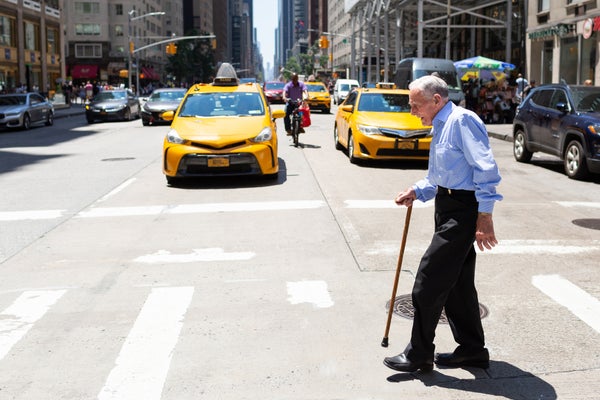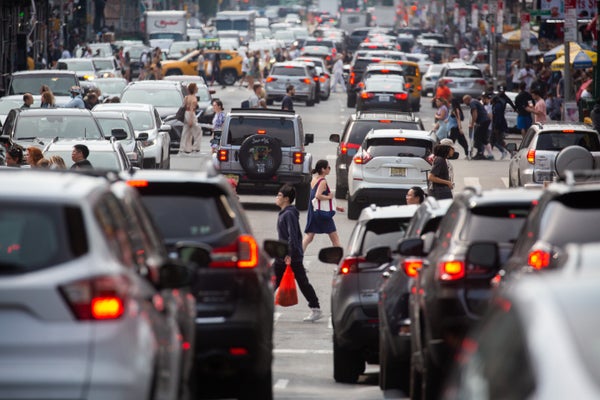Baby Boomers Should Stand Up for New York City’s Congestion Pricing Plan
By canceling congestion pricing for drivers in New York City, the governor of New York State will hurt many retirees, who need the mass transport investments the move promised
Victoria Phipps/Getty Images
Forever young, the baby boomers who turned tax cuts into a civic religion are about to feel the pain of training politicians to shortchange the public as they head for their sunset years. It starts with cars and subways.
When Kathy Hochul, governor of New York State, indefinitely paused congestion pricing at the eleventh hour in early June, she shut down changes seemingly of interest only to New York City’s subway straphangers and bridge-bound commuters. In actuality, the defeat of this measure—meant to bolster public transit use and reduce city traffic—served as yet another accelerant down the road to a looming crisis across the U.S.: the growing inability of aging boomers to travel.
Our country’s 73-million-member boomer generation is enormous and aging. One in five Americans, including all baby boomers, will be aged 65 or older by 2030. And whether it’s because of the housing market or ingrained habits, this generation is aging in place in far greater numbers than ever before, often in the house in which they raised their children. These homes and the communities in which they reside were built, in much of the U.S., on the antiquated American Dream of suburban homes with garages. Decades later this “dream” is darkening: car dependence will make life increasingly difficult for a large population with inevitably declining faculties and physical abilities.
On supporting science journalism
If you’re enjoying this article, consider supporting our award-winning journalism by subscribing. By purchasing a subscription you are helping to ensure the future of impactful stories about the discoveries and ideas shaping our world today.
What this portends is that communities in the U.S.’s cities, suburbs and rural areas will increasingly be called upon to help seniors who are no longer able to drive themselves (or perhaps shouldn’t because of reduced faculties) travel to social visits, medical appointments and community commitments. The alternative is isolation, which, according to U.S. surgeon general Vivek H. Murthy, is one of the greatest impediments to mental and physical health.
Boomers in cities will likely have advantages such as easier access to health care, community resources and fast deliveries than those in car-dependent surrounding areas. They may also have attentive neighbors (though some may be nosey) and corner stores (though some may be noisy) nearby.
Still, the ability to travel easily around cities hinges on the installation of public infrastructure. This can take the form of small but meaningful interventions, such as smooth sidewalks, stair-free building access, and smatterings of public benches and sun-shaded rest spots. Other infrastructure is more resource-intensive to install, including bus boarding ramps, intersection timings that account for slower walking speeds and subway platforms serviced by elevators.
These investments are overwhelmingly worthwhile for those who use them now or someday will. Improving accessibility helps everyone, including those with temporary or permanent disabilities, travelers with luggage and parents with strollers. Serving all current and potential users of a system is key to a successful system.
In New York City, accessibility improvements such as elevators and ramps that will (eventually) be built at 346 subway stations were slated for funding kicked off by the expected $15 billion in revenue generated from congestion pricing. But the congestion pricing reversal has jeopardized New York City’s ability to provide adequately accessible transit services. Without the expected revenue that this fee would generate, the Metropolitan Transportation Authority (MTA) has been forced to cancel or postpone improvements that would help riders who require stair-free access to trains.
The eschewing of accessibility improvements—much less basic needs such as keeping trains in good working order—is discouraging as we face the “silver tsunami” of seniors who will age out of driving and increasingly depend on public transportation. As boomers reach a point where they cannot, should not or choose not to drive, they will increasingly rely on public transit—not only in the transit hubs of New York City and Chicago but also in smaller cities and suburbs, where their family or friends may be unable to assist them with every trip.
In addition to searching the couch cushions for elevator construction funds, the MTA will also be forced to pump the brakes on implementing new innovations in accessibility, such as new wheelchair securements on buses, tactile guideways, apps for audio announcements of visual signage for blind people and people with low vision, haptic technologies for deaf people and people who are hard of hearing, and specialized apps for riders with cognitive disabilities. These cuts especially sting in light of transit agencies across the U.S., led by New York City, boldly broadening their accessibility offerings beyond the elevators and ramps required by the Americans with Disabilities Act to serve those with vision, hearing, cognitive and other, potentially invisible, disabilities.
It’s shameful that accessibility improvements have been stymied in New York City, but it’s shortsighted to think that only New Yorkers will be affected. In fact, the New York City metropolitan region accounts for 8 percent of the nation’s gross domestic product, or GDP, because of its transport of workers at the crux of the information and finance industries, among others. As the subway goes, so does a significant chunk of the American economy. And many riders who rely on the subway’s efficiency now will grow to rely on its accessibility later. Moreover, Hochul’s shortsighted, unexpected cutoff of congestion pricing dismantles what was hailed as a step toward more sustainable cities in the U.S. and a more livable, breathable future nationwide.
President Joe Biden’s administration has invested more heavily in public transportation than any previous administration, noting the importance of efficient, sustainable and equitable mobility across U.S. cities. But it’s also clear that it sees the writing on the wall that access to public transportation serves as a critical safety net for the aging population. One direct path to securing that access was congestion pricing, which is why its “pause” should alarm Americans.
To care for the U.S.’s current and future older adults, we must construct both physical and social infrastructure. To avert a mobility crisis down the line, now is the time to get the U.S.’s senior-focused policies back on track.
This is an opinion and analysis article, and the views expressed by the author or authors are not necessarily those of Scientific American.















